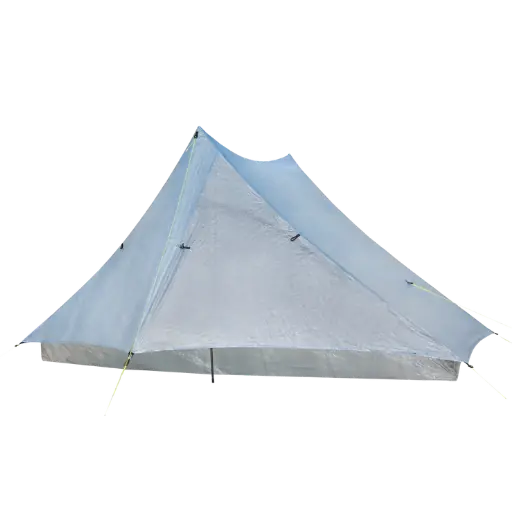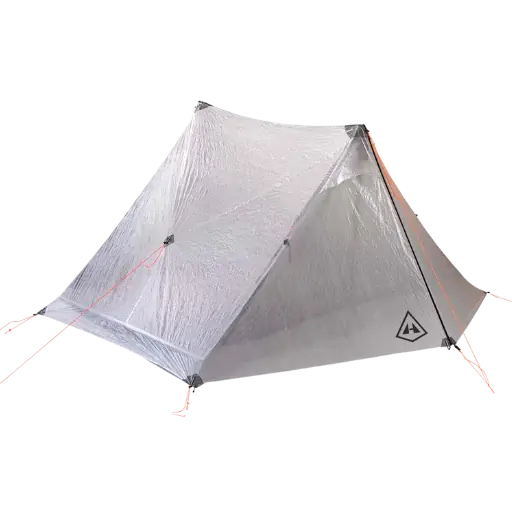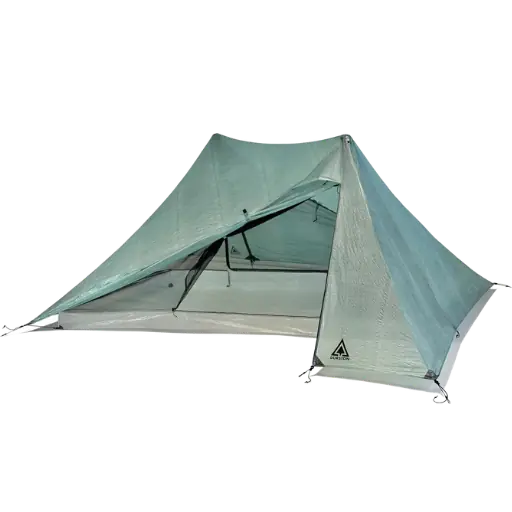When I started back into backpacking and assembling lighter gear, I never thought about tent fabrics, and I found what was the best option at the price I was willing to pay. I started reading about this tent called the Duplex from Zpacks and dug into dyneema. I wanted to know why people were infatuated with it in the thru-hiking world.
For me, it is a perfect option for trail life since it is fast to set up and ultralight to carry for 1000s of miles. Let's dig into the benefits and drawbacks to DCF, as it may be a good decision for you to make when gearing up for a thru-hike.
Understanding the Unique Properties of Dyneema Composite Fabric
Dyneema fiber was built originally for sailboat sails, as it is incredibly strong for its weight and, along with its waterproofness, makes it ideal for constructing a durable and lightweight tent.
Though with all these benefits, there are still problems which cause it to be less used as a material for many manufacturers. It is costly to purchase, machine, and nearly impossible to dye, so you also have very limited color choices.
The High Costs and Challenges of Producing DCF Gear
Much of this has to do with exceptional costs, being both labor-intensive and difficult to acquire and to create, let alone sell. DCF requires very specific needs in equipment to sew it, and this gear isn't the same as traditional equipment.
This keeps the number of companies that can produce DCF products limited to those with a lot of financial backing and those willing to create and possibly suffer losses from failed sales runs.
This has been slowly changing as more and more companies can acquire the right equipment, but it is still a significant investment.
The end product is also much more expensive than what you find, limiting the audience who can and will buy, leading many bigger brands to avoid it entirely.
The Limited Color Palette of DCF Shelters
Most colors are limited to very light colors; the most common are translucent white, blue, and light green.
There is also black, but this makes for a poor shelter color as it warms the interior from the sun's heat, making it unbearable in hot weather.
Field Testing DCF: Strengths and Weaknesses Revealed
Dyneema is a tough fabric, but it is not indestructible. The material's weave can catch on and tear; however, it will not run like traditional nylon fabrics.
You need to be most careful with the seams as they are sewn and not glued, making for a less resistant connection point.
Take care when setting up and taking down your shelter not to catch anything on the corners.
I could not pull apart the bonded seam but I could pull apart every stitched seam that I made. The bonded seam performed as if there were no seam at all, and it was just like trying to pull apart a continuous piece of 2″ wide DCF which I cannot do. - Backpacking Light
One of the great things about DCF is that it can be repaired in the field with needle and thread quite easily as long as you have a little patience.
I have had to do this a few times already, and it has been relatively painless.
Weighing the Pros and Cons of DCF Tents

There are definite pros and cons between a DCF tent and other more traditional materials like sil-nylon.
First, let's look at the Pros:
DCF’s Winning Features: Lightweight, Waterproof, and Durable
There are loads of beneficial parts to DCF as a shelter material that can make the exorbitant cost well worth the investment.
The biggest are weight reduction, waterproof, not stretchable, and strong tear resistance; let's dig in.
Large Weight Reduction
The primary advantage of DCF is how incredibly lightweight it is for what it can do. You will often see a sil-nylon tent that weighs around 3 lbs and then a comparable DCF one at 1.
This is due to most single-wall tents are the gold standard for lightweight shelters on the trail.
Throughout 2000+ miles, this is significant to your bodily health, including your knees and feet. This weight savings also allows you to use a lighter and smaller backpack as you aren't hauling as much weight around.
Waterproof
One of the main reasons that DCF was created in the first place was for sails on boats; it needs to be incredibly waterproof while being lightweight, which made it perfect for extending use into hiking.
This excellent waterproofing extends to DCF tents and excels in heavy rain. At the same time, you may think that since the fabric is waterproof, this alone would keep you bone-dry, but since you need to attach doors and parts to the tent, you create micro holes to attach with a sewing machine.
This means tents have extra work added to either tape these seams in creation, hot bond the DCR layers together, or seam seal with a sealant to help protect you fully in the heaviest of downpours.
Not Stretchable
As DCF is not stretchy, it will hold its shape in all conditions, so you won't have to worry about your tarp or bathtub floor sagging in the rain as waterlogged sil-nylon can.
This also keeps the tent more stable in high winds as it can't flap as much due to the lack of giving.
Massive Tear Resistance
One of the lesser-known advantages of DCF is its incredible tear resistance for how light it is. This is due to the extremely tough fibers used in its construction and is a result of it being designed for sails.
You will often see people use this as their only shelter material on long-distance hikes as it can take a beating day in and day out and still perform admirably.
Potential Downsides: Cost, Transparency, and Noise Issues
There are some drawbacks to DCF as your go-to material, but most are avoidable with a little extra care.
The main issues are its sheer cost, the fact the material is very translucent, providing limited privacy, and that the DCF can make loads of noise when it's windy.
Extremely Expensive & Cost Prohibitive
Any tent body built with Dyneema will not be light on the wallet. For most DCF shelters, you will have to look at paying a minimum of around $600 for the shelter alone without tent stakes.
This is a lot of money for most people and often puts the DCF option out of reach. If you have the budget, it's well worth the investment as you will save so much on weight while not losing any strength or durability.
Near Translucent & Limited Privacy
As I mentioned above, since DCF is so light, it is also very translucent. This doesn't mean you can see through it like a window, but in the right lighting or with a headlamp inside, you can easily make out the shape of a person.
For many, this limits its use as they don't want to be on display, and it is often one of the main reasons people shy away from DCF shelters outside of the cost itself.
Noisy Enough To Interrupt Sleep
Another drawback that can often discourage people is how incredibly loud DCF can be in high winds. When the wind is whipping around your shelter, it can make a loud crinkling sound that can be enough to disrupt sleep.
To help combat this, some companies have started using a thicker DCF that helps to deaden the noise somewhat, but it's still an issue for those particularly sensitive to noise when trying to sleep.
Most Require Trekking Poles
Many DCF shelters are trekking pole tents which means you will need to use trekking poles as the primary support structure. Due to this, if you choose to day hike you wouldn't have them available without taking down your shelter.
While this isn't an issue for some, others may not carry poles or want to use their trekking poles for a chair or other needs, limiting the usefulness of DCF shelters in those situations.
Assessing the Longevity of Your DCF Tent Investment

The lifespan of any tent depends on how you care for it and how often you use and abuse it, and a thru-hike is pretty brutal on gear due to the length of time you use it.
For most, a DCF tent will last them many years if they take care of it, with some companies even offering a lifetime warranty on the material itself.
In terms of a thru-hike, the normal life expectancy would be a single thru-hike. Many people, though, have had their same tent through multiple thru-hikes. Much of this longer life comes from the way you treat the material while travelling.
So the real story is your mileage may vary. You might get years out of a Dyneema tent or just one thru-hike, but what matters is you take care of your gear and know its limitations.
Making the Case for Investing in a DCF Tent
When you are on a thru-hike, you are on the trail, and your shelter is your "home," Most homes will cost you much more than $600-700 dollars and be nowhere near as transportable.
To me, this makes a DCF tent as a shelter for 5+ months worthy of the investment for a thru-hike attempt.
Having a safe place to sleep that is comfortable, dry, and bug-free makes all the difference in the world when you are out there for months.
Due to its durability, the DCF option will cost you less in the long run. So while the upfront cost may be high, the long-term savings make this a great investment for those who can afford it and treat their tent with care.
Ultimately, what matters is what works best for you and what you are willing to spend to make your hike more comfortable.
DCF Tents Recommended by Experienced Hikers
The major players for thru-hiking will be Zpacks, Durston Gear, HMG, Tarptent, and Big Agnes.

Zpacks Duplex Lite
The Duplex Lite is the ultimate ultralight tent for weight-conscious backpackers. At under 15 ounces, it’s the world’s lightest fully enclosed two-person tent.

HMG Unbound 2P
The Unbound 2P Tent is the epitome of reliability and versatility in backcountry shelters. Designed with user feedback from global testers, it ticks all the boxes for a perfect outdoor home.

Durston Gear X-Mid Pro 2
The X-Mid Pro 2 represents the peak of ultralight tent design. Featuring the stormworthy X-Mid geometry combined with a single-wall design, this tent is both ultra-light and highly capable.
DIY DCF Projects: Crafting Your Own Ultralight Gear
The best option, if you want to give this a try, would be to go to RipStopByTheRoll. They are THE place to find everything you need to make nearly any outdoor gear on your own, but it isn't for the faint of heart.
You will have to buy the material, cut it to shape, seal it, and construct the entire shelter yourself. It's a lot of work but can be very rewarding, especially when you finish your first project.
If you don't feel like making your gear, don't worry; plenty of companies produce high-quality DCF gear for you to choose from.
Conclusion: Evaluating the Value and Performance of DCF Tents
DCF has some incredible advantages that make it one of the best materials on the market for ultralight backpacking, and trekking pole-supported tents.
If you can look past the cost, weight, and noise issues, there is no better material regarding strength-to-weight ratio, waterproofing, or tear resistance.
Do you have experience with Dyneema Composite Fabrics? What are your thoughts? Become a member today and let me know in the comments below!






